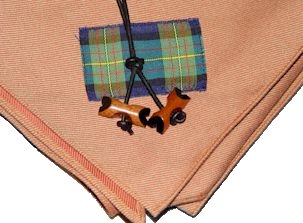A variety of Japanese Scouts Scarfs (or Neckers)
The Scouting movement makes the neckerchief part of its uniform. A generally ceremonial item, the neckerchief is taught to be a practical wilderness item in the Scouting tradition. The neckerchief, unrolled, is designed to be the perfect size for use as a triangular bandage for first aid.
In most countries each Scout Troop uses its own colour neckerchief. The colours are usually the "Troop Colours" which may have a particular historical significance to the troop or to the local community.
In Canada, while most groups use colour neckerchiefs, there is also an optional alternate universal pattern tartan neckerchief: white plaid on red for Scouts, gold plaid on dark green for Cubs. Alternating thick and thin lines of the plaid spell out "CANADA" in Morse code.
Slide (or toggle) with room for "survival materials"
In other countries individual patrols are identifiable by their neckerchiefs and so troops may have many different neckerchiefs all at once. In both of these cases the neckerchief and its colours are an issue of identity, and become emblematic of a troop or a patrol.In Australia, Queensland uses a single maroon scarf for the whole state, while the other states allow groups, Venturer Units and Rover Crews to choose their own scarf. Region and Branch Teams also have their own scarves. Neckerchiefs can also have important ceremonial functions in Scouting, for example, the 1st Gilwell Scout Group present a special neckerchief on completion of the Wood Badge.
Neckerchiefs can also have important ceremonial functions in Scouting, for example, the 1st Gilwell Scout Group present a special neckerchief on completion of the Wood Badge.





No comments:
Post a Comment